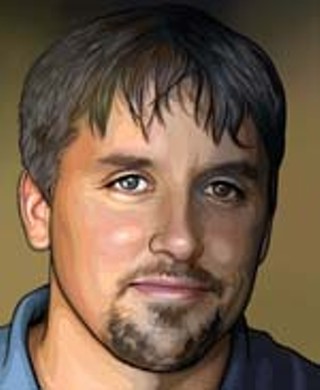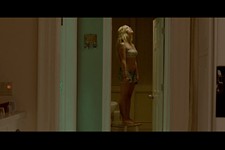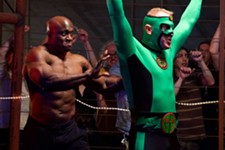Securing the Substance
Richard Linklater on his adaptation of A Scanner Darkly
By Marc Savlov, Fri., July 7, 2006

Richard Linklater's A Scanner Darkly is so trippily in touch with the current cultural zeitgeist that it rattles you to your core. You walk out of the theatre dazed and confused, unsure of whether what you've just witnessed is fiction or fact. Indeed, it's neither, and both.
Adapted from Philip K. Dick's 1977 novel, Linklater's film, undertaken with the blessings of the Dick estate and family, follows the circuitous, drug-induced mental meltdown of Bob Arctor (Reeves), a man for whom paranoia and disassociation from reality are the onrushing norm. Fear of Them and fear of the Self – and which, exactly, is which – is at the core of a story which also carries a very pointed and very cautionary message to those inclined to dabble in pharmaceuticals: Getting fucked up can fuck you up, boy howdy.
From the intense and nuanced characterizations (courtesy of Reeves, Robert Downey Jr., Woody Harrelson, Winona Ryder, and Rory Cochrane, among others) to the cutting-edge rotoscoping software used to animate performances, which were first shot and edited on digital video (as was also the case with Linklater's equally heady Waking Life), A Scanner Darkly eclipses even Ridley Scott's seminal Blade Runner in terms of faithfulness to the author's intended tone and ideas. It blows your mind clear out of your skull, and then it lingers around afterward, kicking up unpleasant notions of where America is going and what's happening to us while we're along for the ride.
The Chronicle spoke to Linklater by phone following the Austin premiere of A Scanner Darkly and learned why, to paraphrase Steve Jobs, 1984 wasn't like 1984 – because 1984 is right now.
Austin Chronicle: A Scanner Darkly is unique in so many ways – animation, story, Graham Reynolds' brilliant score [read "Tone Setter," July 7, 2006] – but I'm curious: Who, exactly, did you make this film for?
Richard Linklater: You know how you have an audience in mind when you make a movie? With this it was someone who loves Philip K. Dick and who will appreciate leaving in the bicycle scene. It was made for the fans, basically.
AC: And the scene you're talking about, for those who haven't read the book, involves a really random, virtually pointless conversation between Barris [Downey Jr.], who's just purchased what may or may not be a stolen bicycle, and his housemates Ernie [Harrelson], Bob [Reeves], and Donna [Ryder].
RL: Right. And that would never pass a Hollywood script committee meeting. It's digressive; it doesn't push the story forward; you could cut it out and you'd never miss it. But, if anything, it tells you so much about their environment, their characters, what they're doing, and just their general state of mind. So, we left that in for the fans.
AC: What's your relationship to the work of Philip K. Dick, and what, specifically, made you decide to bring A Scanner Darkly to the screen?
RL: I kind of came to Dick a little later than most. To my own shame it was even post-Blade Runner. I tend to come to people late, but then I come to them with a passion. I came to Bill Hicks late. I'm never on the cutting edge. But I think it was around 1985. A girlfriend gave me Valis, and by that point I'd seen Blade Runner, so it was a case of where you think you know somebody because you know their most famous work. I read that – that's an interesting one to start with – and then began backtracking from there, picking up new ones as I went along.
Philip K. Dick was kind of floating around Waking Life a little bit, obviously. He's mentioned in the movie, and I remember just wondering at that time what Philip K. Dick story I could work with. Initially, I flirted a little bit with Ubik.
AC: Why did you rule that one out?
RL: That was a rights isssue. I did a little adaptation on my own even though I couldn't get the rights, and I just couldn't quite crack it, you know? I segued to Scanner pretty quickly – this was back in 2001-02.
AC: What was it about Scanner that made you think it was the one to do?

RL: Well, it seemed like a movie I could make. First off, I loved it. I always was attracted to it on a personal level. There were personal reverberations with Philip K. Dick. You read it and you feel that the events and characters in the novel clearly had to have been a part of Philip K. Dick's life at some point. And all those characters seem like roommates I had had, you know? Pretty soon you're living with these people, and you're not entirely sure how. Someone moves out, and they move in, and it's almost like you've suddenly got your own little dysfunctional family. Or functional, actually. That was sort of my 20s living in Austin: People coming and going and all that. That felt really real to me. The dialogue and all. It's science fiction, sort of, with the scramble suit and the sci-fi plot, but to me it's really about this guy's life and what he's given up and the world he finds himself in and the larger implications of that. Those Philip K. Dick questions about the nature of your reality and where you're going. That always resonated with me quite a lot.
AC: Your adaptation seems almost tailor-made for the midnight movie/stoner audience, and I mean that in a good way. Because of its intellectual chewiness and the animation angle, it's a cult movie right out of the gate.
RL: Yeah. Cautionary tales like this always – I mean, I assume they always will – find their audience. The same way with gangsters like The Godfather.
AC: Or Scarface.
RL: Exactly. Or Goodfellas. Stoners will like this because it's of that world. And, you know, you don't have to tell someone on drugs that it's a dangerous thing to dabble in. They know the cautionary tale. It's around them all the time. They don't need to be lectured about it, really. But, honestly, I don't know who the film is for. It's difficult to speak to that. But, then again, I think [stoners] will [enjoy the film], just because of the banter, the camaraderie. The film, to me, shows the upside of that environment – the exuberance, the wit, the communal, all those aspects of that lifestyle that are attractive – and I wanted the film to be very honest about that and show that part. When I was talking to Philip K. Dick's daughters, I said, "Yeah, it'll be a cautionary tale, for sure, but at least it won't be a vacuous Just Say No admonition." Because that throws kids off, you know? When you're a teenager, adults tell you just not to do something as an absolute, and then you see people who do do drugs, and you see that they're actually having fun, and it looks like a fun alternative to the straight, boring world. And then, of course, you think that adults have lied to you completely, and you think all drugs are good. A more healthy approach would be to say, "Hey, if you're going to do that, be careful, here's the down side," and like that. It's sort of like pregnancy and sex. You take it as an inevitability and then just be smart about it. Protect yourself from diseases, be cautious. And it should be the same way with drugs. At least the film acknowledges an upside and then tells you to be really careful about what, exactly, you're doing to your body.
AC: Did you intend for the film to speak directly to the current age of paranoia that we, as a society, are finding ourselves more and more embroiled in? Or was that just a byproduct of adapting Philip K. Dick?
RL: That was one of the questions in the adaptation. I guess the obvious one was where do you set the story, in terms of what year it is and so forth. Remember the film version of 1984? It came out in 1984, and it was set in 1984, but it was set in what Orwell thought the world of 1984 would look like when he wrote the novel in the Forties. Which is interesting conceptually, and I guess you could've gone that way with this film, but Philip K. Dick was far too prescient and far too forward-thinking to do that. ... That's probably why it resonated with me and made me want to do the film: It felt so damn contemporary. There's this post-9/11 mindset, and it's exactly like the world Philip K. Dick imagined with this drug war and the blending of that with this war on terror. Our two twin unwinnable wars that we've got now, you know? They're just going to go on indefinitely, and Dick saw pretty clearly how that wasn't going to help any citizens and instead was just another form of control under the guise of helping people. I think Philip K. Dick knew very, very instinctually and very, very clearly, what he was talking about in regards to that. Because he had been through it. He knew how it worked: No one really gives a fuck about you. It's just how they can profiteer off your ass. And he takes it to the full extreme of paranoia, where you'll become a kind of slave labor to the Powers That Be.
I was talking about drugs in relation to this movie the other day, and I remembered people in the Seventies talking about a designer drug that needed to be invented, you know, like a "good" drug, because apparently a large percentage of the population has a very definite need to try and transcend themselves ritualistically or whatever. And this has always been a part of the human spirit, but what people were talking about was a drug that was nonaddictive, safe, and useful. In the book and the film, this Substance D is quite the opposite. It's immediately addictive; it hollows out your personality and your self, and it leaves you as a laborer for the Powers. The political thinking of the book seemed extremely contemporary to me, and it's actually become far more contemporary since we shot it two years ago. And that will probably continue to be the case. Philip K. Dick knew how power works.
AC: Why did you decide to do this as an animated film?
RL: I had it in mind as animated from the get-go. But I still had to kind of fight the fight, which is probably one of the reasons the film didn't happen for two years after I wrote it. The word came down from above that adults don't really go to animated movies. And this is obviously not a kids' film. So it kind of lingered in the background for a while. It wasn't until the actors came aboard and we kept our budget low that it began to happen. I don't think it would have benefitted from being a $25 million, live-action studio production. I think that's where the adaptation would lose itself. That's where you would lose the bicycle scene; that's where you would introduce more of a cops-and-robbers type of thing; that's where you do have a shoot-out. I could see where, unconsciously or not, the Philip K. Dick part would just drift away. So the best way to do this was with animation. We just kind of hunkered down and said, "Let's make it happen, keep it cheap, tell the whole story, let it be what it wants to be." I'm lucky. I'm lucky Keanu and the other actors came aboard because that's what got everybody excited. The script I'd written, people kind of liked it, but they also didn't really get it. They thought it needed a lot of work, quote-unquote, and that attitude suddenly got a lot better once the actors came onboard. It was suddenly like, "Oh yeah, this could be good!" I love it how that happens.
AC: And that wasn't your most potentially damaging hurdle. Can you talk a little bit about the fact that the film came very close to being shut down after postproduction had already commenced? Head of animation Bob Sabiston, who developed the animation software used on both this film and Waking Life, was replaced by local animators Paul Beck and Jason Archer [who also worked on Waking Life], although all three now share a "Head of Animation" credit, right?
RL: There's a ton of misinformation out there. I'll keep it really simple by saying that this was a huge undertaking, bigger than any of us could have imagined at the time, and whatever, you know, changes took place during the early stages of us really getting going on this had everything to do with management and not art. It was a budgetary concern, essentially. It's no one's ideal situation, and no one comes out of it happy, but this happens a lot on films. People get replaced when you've got a lot of people working and deadlines are not being met and people are getting nervous. It's unfortunate, but we did rebound, and at the end of the day I'm really happy. We're not exactly the first film that had some bumps along the way. It's clearly my most painful postproduction. [Production and postproduction] couldn't have been more opposite, for me. The casting, writing, rehearsing, shooting, editing, boom – as smooth as it's ever been for me. Seriously. OK: Lock picture and we start this animation process, and it becomes a whole other world altogether. But I think that happens when you're fundamentally trying to do something that hasn't been done before and you're creating something that, while we had the technology, the exact methodology of how to get there is kind of being invented as we went along.
AC: How did this compare to making Waking Life, which was also animated with Bob Sabiston's software program?
RL: Night-and-day different. Similar technology, fundamentally the same, but because of this very consistent look that I wanted, this graphic-novel-come-to-life kind of look, it required each scene looking like the scenes the preceded and followed it. Waking Life, on the other hand, had different artistic sensibilities practically to each scene, and I think that worked perfectly in the context of that film. Each sequence in Waking Life is drawn differently, each has its own life. [A Scanner Darkly] is a story, unlike that, which wasn't a story at all, and it required a consistency which puts us back toward the old Disney style, with design sheets and people specializing in one single aspect.
AC: No regrets, then?
RL: Boy, it's been a long haul. But I feel very lucky. I feel like I'm the luckiest filmmaker alive. ![]()
A Scanner Darkly opens in Austin on Friday, July 7. For a review and showtimes, see Film Listings.










